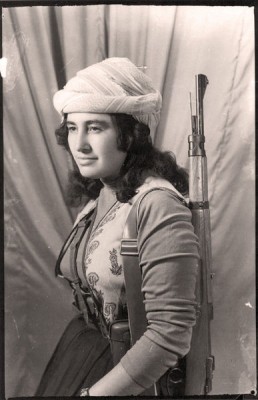
Two armed female members of the YPJ, a group affiliated with the People's Protection Units (YPG), walks around the base near Ras al-Ayn, a Kurdish town located in northern Syria. 11 October 2013. Photo by Younes Mohammad. Copyright Demotix
Women fighting in the ranks of the armed Kurdish forces have come into the spotlight as ISIS has made large territorial gains in Mosul, one of the largest cities in Iraq, and battled to take control of the autonomous Kurdish canton of Kobane on the border of Turkey.
International media agencies and activists alike have pushed images of female Peshmerga in their coverage and on social networking sites. The idea of women in uniform, heavily armed, fearless and fighting alongside men seems to be enticing, perhaps even captivating because it is perceived to be one of the strongest messages of defiance in the face of ISIS — a notoriously brutal Al Qaeda offshoot responsible for mass killing of Iraqi soldiers, Syrian soldiers, aid workers, journalists and the kidnapping, rape and forced marriage of women. In the group's Mosul manifesto, ISIS requires the confinement of women to their homes, unless absolutely necessary.
It seems not a day passes without these images of female fighters being shared. The truth is, contrary to the sudden surge of attention, Kurdish women are not new to the battlefield. Arguably all the battles Kurds have fought historically have been either side by side with women, and/or with the complicity of women as caretakers at home, raising a new generation, taking care of domestic affairs, earning a livelihood and so on.
Nahida Ahmed: We wanted to join #Peshmerga to send the message that there is no difference between men and women. pic.twitter.com/iAR1SssQM7
— Para Keta (@ParaKeta) November 13, 2014
PKK Women Fighters show Peshmerga soldiers how to handle the AK-47 in Kirkuk pic.twitter.com/jhxVHr1ExH
— Qêrîna Bêdeng (@Qerina_Bedeng) November 11, 2014
Gotta love the commitment shown by these Kurdish women as they volunteer to aid #Peshmerga against #ISIS. #NO2ISIS pic.twitter.com/XitnFcXIe6
— Mustafa Al-Khaqani (@Iraqism) August 20, 2014
IS getting smashed by the women it wants confined to their homes is immensely satisfying. http://t.co/OtOxvGZvC7 pic.twitter.com/Br6KnBntmG
— Mahmoud (@MahmoudRamsey) August 13, 2014
The obsession with female fighters against ISIS seems to be premised on the idea of defiance. The Peshmerga women have battled with ISIS fighters, and standing on an equal footing with men in their ranks is evidently perceived to be an alien concept in the Middle East.
However, there are dozens of examples which illustrate that women fighters are not new, but have existed within Kurdish communities historically. Take the following picture of Margaret George Shello for instance, who was among one of the first photographed women to go to the mountains with the Peshmerga and became a symbol of women’s participation in the Kurdish struggle.
The Kurdish people's struggle in Turkey, which led to the emergence of armed groups such as the Kurdistan Worker's Party (PKK) in the 1970s, consists of both men and women to the highest chain of command. In other words, female fighters in Kurdistan is not new, but mainstream media outlets have been very gender-selective in portraying the Kurdish struggle for autonomy (and independence).








10 comments
It does help, that Kurdish women are rather attractive..
It could only get better if they went topless ,think of the attention the world would give the Kurdish people then .
shoooting machine guns with boobies
I think the presence of the Kurdish women fighters is the only reason Europe’s Left hasn’t gone in complete ISIS protection mode. A guiding principle of the international Left is “The enemy of my enemy is my friend,” which has spawned all these anti-Islamophobia activists that attack atheists in the West and harp on supposed transgressions by the West as the root cause of all conflict in the Middle East. That feels somehow like a way to resurrect a Marxist dialectic that has been completely discredited elsewhere. Unfortunately for these Marxist Islam defenders, the PKK has a long Marxist pedigree and attractive armed women in fatigues, a combination that is just too irresistible for the arm-chair Che’s of the West.
I’m a British-based student and haven’t seen a hint of a leftie defending ISIS.
brave girls ,girls kill that filthy pigs(isis) and save your children,sisters,brothers,mother,moreover protect your community and your city,kobane,i know you have courage for that ,bcoz truth is on your side so god too.even though i am not with you,i know how much your people suffer under that basdards(isis).one thing is sure ultimate victory will be yours.i am an indian,i always pray for you.and one more thing all of you,kurdish women fighters,are extreme beautiful and gorges .if you are an indian ,we will not let you to fight bcoz we don’t want to spoil your beautiful life.may god bless you